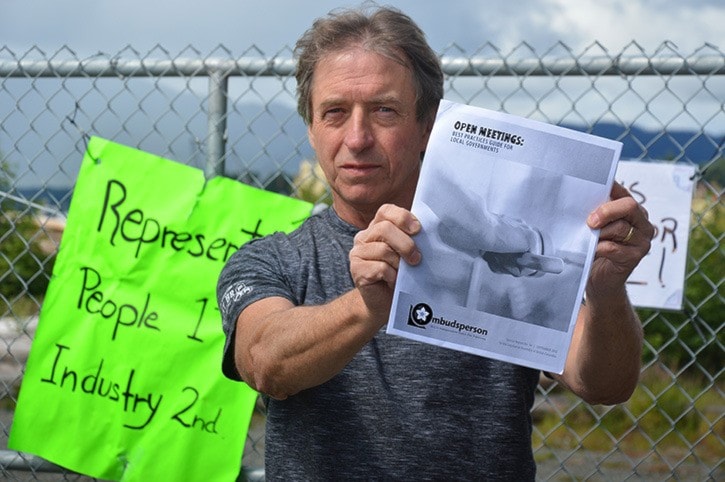Former Port Alberni mayor John Douglas calls the City of Port Alberni’s pending sale of plywood lots A and B without proper public consultation ‘tragic.’
“I feel that it’s just a tragedy that the council seems to have gone ahead and done this without a proper public consultation process,” said Douglas.
“They haven’t given the public an opportunity to voice their concerns.”
City council declared their intent to sell plywood lots A and B to the owners of Canadian Alberni Engineering for $250,000 at their May 24 meeting. At the June 13 meeting, council confirmed that the two-week notice of sale period for the lots had ended.
The city can now finalize the land sale.
(Interested in the history of plywood lots A and B? Read about the initial lease to the port authority in 2014 here, the public's reaction here, council's discussion about terminating the lease in summer 2015 here, the city's decision to terminate the lease here and the end of that lease here.)
“When we negotiate land sales, we’re going to do that behind closed doors,” said Mayor Mike Ruttan, following a packed meeting where a few residents stated their distaste for what they view as the secrecy surrounding the sale.
“We followed the Community Charter,” Ruttan said.
The Community Charter, which sets out what subjects can be discussed by city councils in-camera (or privately), allows for land sale negotiations to stay in-camera.
The plywood land was previously leased to the Port Alberni Port Authority by the council that Douglas led as mayor—he voted against the lease.
Between July 2014, when the lease was signed, and Oct. 2015, when it was dissolved due to lack of progress, PAPA tried unsuccessfully to lease the land to Canadian Alberni Engineering.
Waterfront advocates have argued for years that lots A and B should follow the example set by lot C—now known as Canal Beach—and be developed into public access greenspace.
“Most of Port Alberni’s waterfront is locked up behind gates with no public access,” said Sandra Gentleman, founder of the Canal Beach Watersports Society and a steward of Canal Beach.
“And only five per cent of it is owned by the city.”
Gentleman said that while service groups had been approached, the issue was just too political to gain traction. A Change.org petition supporting a waterfront greenspace on the former plywood lots had gained over 350 signatures, sparking an accusation from Gentleman that council was not listening to the public—something she said is more important than whether or not the plywood lots become greenspace.
“They didn’t listen to the public,” she said.
Waterfront advocate Alicia La Rue agreed.
“That’s public input—let people speak and maybe people could very well say ‘we want it to be industry.’”
The city did recently acquire ‘Esso Beach,’ a grassy lot leading to the water near a boat launch between Harbour Quay and Harbour Quay Marina but Ruttan said that the city considered a sale to industry of the former plywood land the best use of lots A and B.
“We’re really concerned and really aware of the needs in this city of creating opportunities for employment,” said Ruttan.
La Rue disagreed with the notion that industry will bring the kind of jobs and taxpayers to Port Alberni that the community needs.
“Let’s be creative here. This is prime real estate that we can solve problems with, instead of making problems.”
Gentleman argued that the land doesn’t require the expensive remediation that has been used in the past as a reason for city council to rid itself of the lots.
“The contamination is under ground,” she said, adding that since the lot is paved and there wouldn’t be direct water access from it, it could just be covered with soil and seeded.
A 2013 environmental assessment done on the three plywood lots showed Lot A was the most heavily contaminated, with evidence of heavy metals, petroleum hydrocarbons, groundwater contaminated with zinc and an oil product discovered floating on the groundwater table was likely weathered Bunker-C oil.
The cost to remediate the lots was more than $5.5 million in 2013 dollars.
A 2011 risk assessment of Lot A and Lot C that SLR Consulting (Canada) Ltd. did on the city’s behalf noted there were contact risks for people dealing with contaminated soil, groundwater, vapour and sediments in the first few metres of soil.
While council is moving ahead with land sale proceedings for the plywood lots, not all councillors are happy with the decision.
Coun. Chris Alemany, who questioned city staff on various points of the lease, said “I do think there’s ways that we could have gone about the process where we wouldn’t have had a full house breathing down our necks because of a decision that has already been made.”
“We have a commitment to be more open and transparent than I think we’ve shown to be on this issue. I think there’s many options that include getting rid of the covenant if the public sees that as a direction and it did in past reports in 2007... I think when we approach controversial issues, we should take that as an opportunity to engage the public rather than disengage.”
That statement sparked applause from the audience but a less positive response from Ruttan.
“You were part of the process right from the beginning as well, just like everybody else. This is a council of seven, not a council of six minus one.”
Following the meeting, Ruttan said that Western Forest Products, who hold a restrictive covenant on the lands that prevents overnight accommodation and any other uses besides industrial or commercial, was not interested in negotiating it away.
La Rue didn’t agree that it was impossible.
“What have other municipalities done to remove covenants? There has to be a way.”
